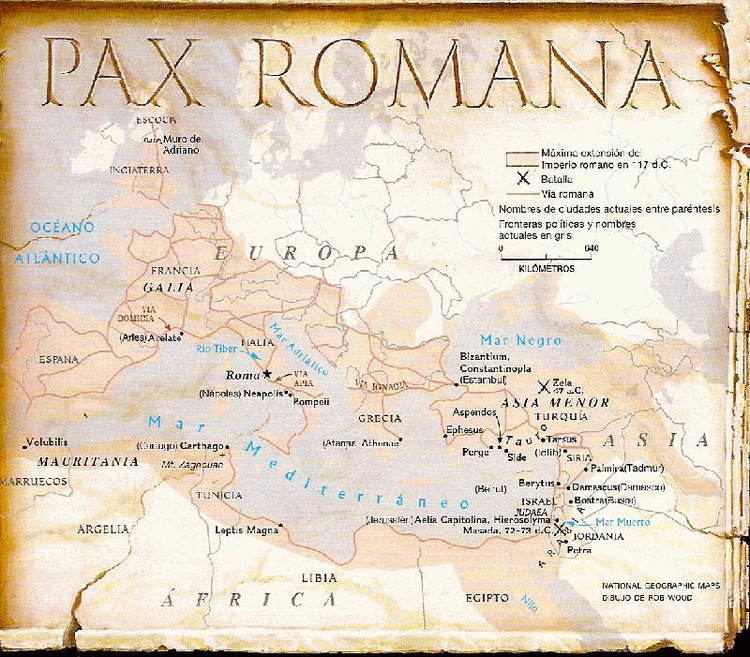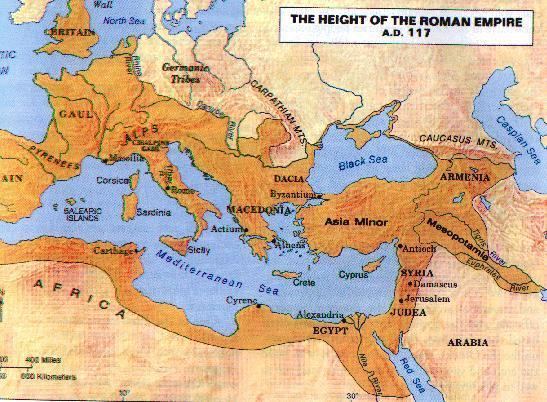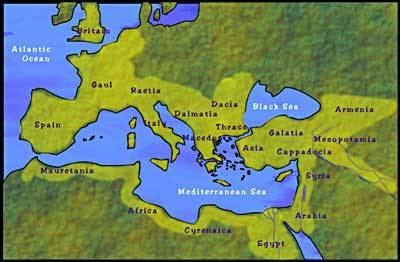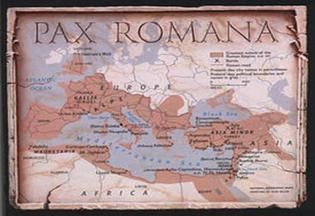Pax Romana (Latin for "Roman peace") was the long period of relative peacefulness and minimal expansion by the Roman military force experienced by the Roman Empire after the end of the Final War of the Roman Republic and before the beginning of the Crisis of the Third Century. During this time, the Roman empire reached its peak land mass area and its population grew up to 70 million people. Since it was established by Augustus, it is sometimes called Pax Augusta. Its span was approximately 206 years (27 BC to 180 AD).
Contents
- Emperors of pax romana world history khan academy
- Overview
- Similar terms generic notion
- In fiction
- References

Emperors of pax romana world history khan academy
Overview
The Pax Romana is said to have been a "miracle" because prior to it there had never been peace for so many centuries in a given period of history. However, Walter Goffart wrote: "The volume of the Cambridge Ancient History for the years A.D. 70–192 is called 'The Imperial Peace', but peace is not what one finds in its pages". Arthur M. Eckstein writes that the period must be seen in contrast to the much more frequent warfare in the Roman Republic in the 4th and 3rd centuries BC. Eckstein also notes that the incipient Pax Romana appeared during the Republic, and that its temporal span varied with geographical region as well: "Although the standard textbook dates for the Pax Romana, the famous “Roman Peace” in the Mediterranean, are 31 BC to AD 250, the fact is that the Roman Peace was emerging in large regions of the Mediterranean at a much earlier date: Sicily after 210 [BC]; peninsular Italy after 200 [BC]; the Po Valley after 190 [BC]; most of Spain after 133 [BC]; North Africa after 100 [BC]; and for ever longer stretches of time in the Greek East."

The first known record of the term Pax Romana appears in a writing by Seneca the Younger in 55 AD. The concept was highly influential, and the subject of theories and attempts to copy it in subsequent ages. Arnaldo Momigliano noted that "Pax Romana is a simple formula for propaganda, but a difficult subject for research." In fact, the "Pax Romana" was broken by the First Jewish–Roman War, the Kitos War (also in Judea, 115–117), the Bar Kokhba Revolt (also known as the Third Jewish–Roman War), the Roman–Parthian War of 58–63, Trajan's Roman–Parthian War of 113, and Boudica's war in Britain in AD 60 or 61.

The Pax Romana began when Octavian (Augustus) defeated Marc Antony in the Battle of Actium on 2 September 31 BC and became the Roman emperor. He became princeps, or first citizen. Lacking a good precedent of successful one-man rule, Augustus created a junta of the greatest military magnates and stood as the front man. By binding together these leading magnates in a coalition, he eliminated the prospect of civil war. The Pax Romana was not immediate, despite the end of the civil wars, because fighting continued in Hispania and in the Alps. Nevertheless, Augustus closed the Gates of Janus (a ceremony indicating that Rome was at peace) three times, first in 29 BC and again in 25 BC. The third closure is undocumented, but Inez Scott Ryberg (1949) and Gaius Stern (2006) have persuasively dated the third closure to 13 BC with the commissioning of the Ara Pacis. At the time of the Ludi Saeculares in 17 BC the concept of Peace was publicized, and in 13 BC was proclaimed when Augustus and Agrippa jointly returned from pacifying the provinces. The order to construct the Ara Pacis was no doubt part of this announcement.

Augustus faced a problem making peace an acceptable mode of life for the Romans, who had been at war with one power or another continuously for 200 years. Romans regarded peace not as an absence of war, but the rare situation which existed when all opponents had been beaten down and lost the ability to resist. Augustus' challenge was to persuade Romans that the prosperity they could achieve in the absence of warfare was better for the Empire than the potential wealth and honor acquired when fighting a risky war. Augustus succeeded by means of skillful propaganda. Subsequent emperors followed his lead, sometimes producing lavish ceremonies to close the Gates of Janus, issuing coins with Pax on the reverse, and patronizing literature extolling the benefits of the Pax Romana.
After Augustus died in 14 AD many other Roman emperors ruled during this time. One of which named Caligula ruled from 37 AD to 41 AD. Caligula was considered a vicious sadist and sexually perverse who eventually was assassinated by his own guards. The last five emperors of the Pax Romana were considered the "Five Good Emperors".
Similar terms generic notion
The prominence of the concept of the Pax Romana led to historians coining variants of the term to describe other systems of relative peace that have been established, attempted, or argued to have existed. Such times have been credited to the British Empire during the 19th century. Some variants include:
More generically, the concept has been referred to as pax imperia, (sometimes spelled as pax imperium) meaning imperial peace, or—less literally—hegemonic peace. Raymond Aron notes that imperial peace—peace achieved through hegemony—sometimes, but not always—can become civil peace. As an example, the German Empire's imperial peace of 1871 (over its internal components like Saxony) slowly evolved into the later German state. As a counter-example, the imperial peace of Alexander the Great's empire dissolved because the Greek city states maintained their political identity and more importantly, embrios of their own armed forces. Aron notes that during the Pax Romana, the Jewish war was a reminder that the overlapping of the imperial institutions over the local ones did not erase them and the overlap was a source of tension and flare-ups. Aron summarizes that, "In other words, imperial peace becomes civil peace insofar as the memory of the previously independent political units are effaced, insofar as individuals within a pacified zone feel themselves less united to the traditional or local community and more to the conquering state."
The concept of Pax Romana was highly influential, and attempts to imitate it occurred in the Byzantine Empire, and in the Christian West, where it morphed into the Peace and Truce of God (pax Dei and treuga Dei). A theoretician of the imperial peace during the Middle Ages was Dante Aligheri. Dante's works on the topic were analyzed at the beginning of the 20th century by William Mitchell Ramsay in the book The Imperial Peace; An Ideal in European History (1913).
